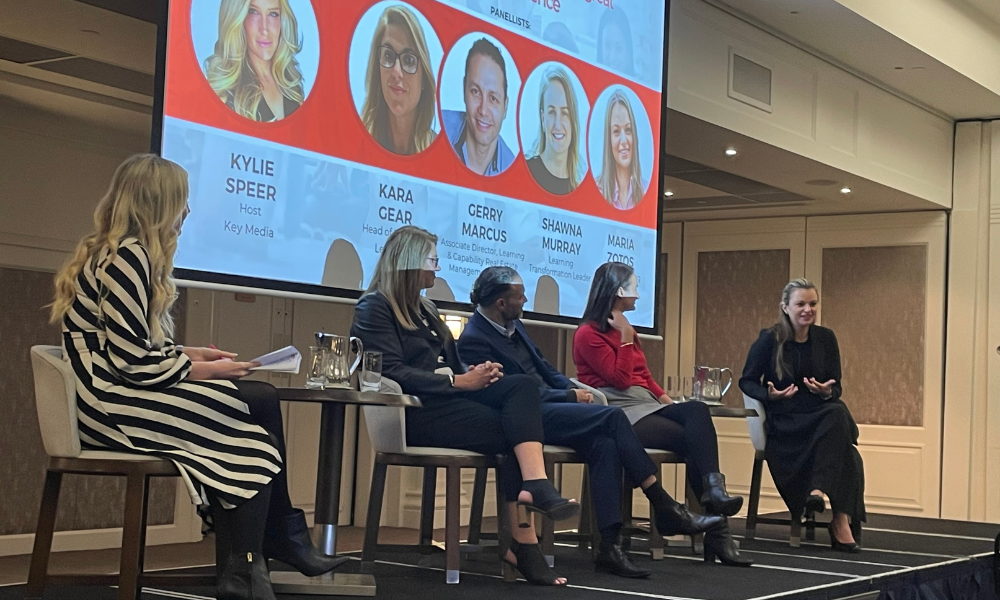
'Self-development starts with self-insight,' says expert

Learning and development is something that has gone from being a ‘nice to have’ to a mandatory element within a lot of organisations, according to Karlie Cremin, managing director of DLPA (Dynamic Leadership Programs Australia).
Cremin shared this sentiment at HRD Australia’s Learning & Development Summit, which was held at the Swissotel Sydney this week. The summit involved a day full of sessions with insights to help business leaders reach their skill development goals and keep workers engaged. There were also several workshops including LHH’s workshop on bridging the leadership development gap.
Cremin held a session on using neuroscience to support learning in a hybrid work environment. She discussed theories and frameworks such as the AGES framework for learning – an acronym for attention, generation, emotion and spacing.
“It is around how do you actually make that learning sticky,” she said. “When I say sticky, that's about how it actually generates behavioural change and how people remember it within a situation.”
While ‘attention’ refers to getting and holding the attention of your employees, Cremin said with ‘generation’, “we hold information better where we generate ideation around it”.
“That's where, within a training context, you'd be looking at things like structured conversations and sharing,” she said. “You’d look at more specific scenarios and getting people to actually think through and generate their ideas that come off the content.”
Cremin went on to say that emotion is fairly straightforward but harder to get exactly right.
“Where people are engaging in something on an emotional level, they're more likely to have a memory associated with it,” she said. “Which is how we make learning sticky, in that we're hooking onto a memory about something.
Using fun in learning programs can help.
“We will frequently and very deliberately embed fun within our programs because we know when people are having fun that the memory is likely to be easier to access when the time comes,” she said.
“And then spacing is where you have a bit of learning, a gap, and then learning again. Something that is important in that space is sleep, and ideally, good quality sleep.”
The HRD Learning & Development Summit included exhibitions from Edtech provider academyEX and BloomXR, which specialises in artificial intelligence (AI) and extended reality (XR).
One of the key topics discussed during the event was the use of artificial intelligence (AI) in learning and development.
Evelyn Moolenburgh, managing director at Learning Ventures, said AI is a game-changer.
“It really is going to help us be more effective,” she said. “And I think we have to look at it that way and not as something to be afraid of. It's just going to aid what we do and allow us to spend a lot more time on the things that are actually going to make a difference.”
Moolenburgh went on to discuss ways that generative AI can be used – such as in content design and skill-gap analysis, knowledge application, individual learning and development plans, and succession planning.
In a different session around achieving effective leadership development through L&D, Dr. Denise Meyerson, director, MCI, encouraged attendees to trial new things when it comes to AI.
“Pilot [it],” said. “If it doesn't work, too bad. Don't invest millions in it, give it a go. With AI, some of this stuff is free. So the only downside is a bit of your time and a few leaders who maybe have put their time into it. They’re still going to learn something.”
The summit held panels and case studies including supporting career and talent mobility plans to engage employees, moderated by LinkedIn Learning, and TSA Management’s case study on developing a successful L&D program on a budget.
In the panel about leveraging human-centered, personalised L&D design, GoodHabitz Australia country director Cam Elliot described how the company has assessments to help users determine their learning style and learning journey.
“One of our principles is that we believe that self-development starts with self-insight,” he said. “So if I can learn more about myself, about my style, how I communicate, how I lead, whatever it is, then I can start to understand what are my strengths, what are my weaknesses, what are my blind spots, all those sorts of things. And if we can get that, then that's the starting place for the learning journey.”
Belinda Barron, learning and development manager, NEXTDC, discussed the integration of micro learning to achieve continuous skill development while minimising the impact on daily routines.
“Each year, we have roughly around 20 people [who] go through that program,” she said. “But to teach them and coach them right at the start of the program – they're on it for a 12-month period – they're all extremely busy and have large roles. But what can they create, two to three development goals, that they’re going to work on over the next 12 months that is personalised to them.”
The HRD Learning & Development Summit included event partner DLPA, along with gold sponsors GoodHabitz and LinkedIn Learning, workshop sponsor LHH and exhibitor sponsors academyEX and BloomXR.